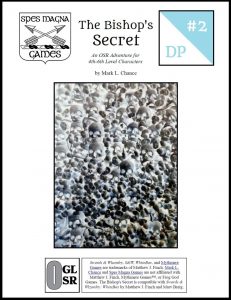
By Mark Chance
Spes Magna Games
Swords & Wizardry
Level 4-6
Bishop Pausanias, gray haired with merry blue eyes and respectable girth, has long been one of the city’s pillars. He is famed for his charity and the holy protection he exercises over his city. So why do ghouls stalk the city at night? Why, on moonless nights, do zombies shuffle down streets, and what horror murders the faithful in their sleep? What is The Bishop’s Secret?
This eleven page adventure details a small nine romo underground tunnel complex and a bit of plot in the city above. It’s got a nice undead vibe going on, and the city intrigue is explained in just enough detail to make it work well. The writing style, though, is conversational. You’ll need a highlighter, and there’s no room in my new condo for a highlighter.
This thing is above average in a couple of areas. First, it provides some good summary information for a plot in town. The adventure is basically just a nine room dungeon, but the little bits provided before the dungeon description provide a nice little overview of ways to involve the party. A gang of thugs the bishop uses when he needs people. Corrupt priests. Dead walking in the streets. It’s just a little, but it’s enough for the DM to craft something around that’s a little more than a throw-away investigation. It’s a decent way to handle the context of the dungeon. This kind of matches my view on hooks. Either you don’t include them or you make them more than “You are caravan guards.” You don’t have to write a book, but a few specifics in order to get the DM’s imagination going seems to be the correct amount of length.
It also does a pretty good job of painting a picture of an Undead adventure. Muddy tunnels with water in them. Low. Cramped. Claw marks here and there. The smell of rot. Weird echoing sounds. It does a good job of providing some atmosphere for the DM to work with. A bowl stained by blood from gory libations. It’s decent text.
It’s also buried in a conversational writing style. “IF characters speak in this chamber” is a classic example of IF THEN writing style, a kind of indirect style that pads text out. “As with the Mausoleum of the Patriarchs, the gated area to the spiral stairs leading down to this area is kept locked.” Well, yes, I lie the idea of a locked gate in a church leading down to the crypts. But the first clause is, again, just padding. I’d have liked to see better editing and use of whitespace to separate out descriptions from mechanics.
The treasure also seems quite light for a gold=xp system. It feels more like the token “treasure parcels”of 5e than the riches of gold/xp.
This is clearly trying, but the organization of the text is far too … loose for me. You have to make an effort, find a highlighter, etc. I choose Pikachu instead.
This is $2 on DriveThru. The first few pages of the preview are good examples of what you get … and in fact the entire adventure is there in the preview. The second and third page shows you the loose information for the town data/plot that I liked so much. The fourth page onward shows you the adventure and the writing style in the rooms that I think is too loose. https://www.drivethrurpg.com/product/239435/DP-2-The-Bishops-Secret?affiliate_id=1892600

I think this is a fair review. I had a quick look at the third in the series “Narvon’s Sinister Stair” and much the same comments that apply to this adventure apply to that one. I do like the backstory to the dungeon in “Narvon” though, conveying it to the players would be the challenge.
Okay, serious question. How else would you communicate that something only happens conditionally but through the phrase “if characters do [X]…”? “When a character…” isn’t any shorter. I’m not defending this module in particular, but this has been a theme in recent reviews, and I just realized I don’t know how else you would do it.
A classic DaveR question!
It’s not so much an absolute rule. In the context it is “If the players enter the room they see …”
You could start nearly every sentence that way. “IF the characters touch the desk they find out it feels oily” and so on.
Contrast with something like: “The desk has a light sheen of oil on it.” That covers sight, smell, and touch.
I generalize this sometimes by saying writing should exists outside of the characters.
It’s a similar exercise to turning your writing from passive voice to active or vicey versey.
I think it’s more than just taking longer to say the same thing. When we rephrase to remove “if/then”s we show more of the workings of the world.
“If the players pull the lever the water will rise” to “The lever controls water flow”
“If the players call him a snickerdoodle he’ll attack” to “Snickerdoodle is a mortal insult in this society”
“If the players offer the duchess a magic wand she’ll help them out” to “The duchess wants a magic wand above all else”
“If the players start looking for the ring while Georgie is in the room he’ll get antsy” to “Georgie feels uncomfortable going through someone else’s belongings”
This way we get mechanisms, motivations, general rules—the sorts of things we need in order to improvise well.
Sorry to hear about the new living situation, Bryce.